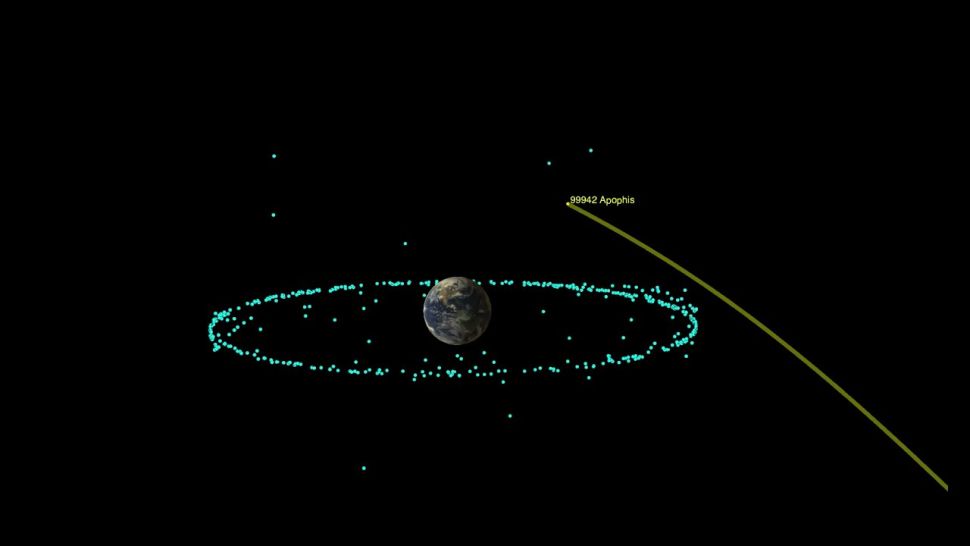
Path of asteroid 99942 Apophis coming within 20,000 miles (32,000 kilometers) of Earth. (Image courtesy of: NASA/JPL–Caltech
We’ve all seen movies about asteroids slamming into Earth. Generals sitting around tables in clandestine military rooms watching LED displays of the object moving towards our planet. Loud orchestral music playing out the tense atmosphere. But what does tracking a potentially deadly asteroid really look like?
In 2004, astronomers at The B612 Foundation, a nonprofit that supports research and technologies for mapping the solar system, first gave word of a large asteroid that seemed to be taking a course that would come dangerously close to Earth. Dubbed 99942 Apophis, astronomers began the difficult task of sourcing enough orbital data and research to be able to determine if the mid-size asteroid would make an impact. Astronomers theorized that the asteroid could likely hit Earth in 2029 or 2036. Thanks to the hard work of The B612 foundation and the greater scientific community, refined calculations were able to rule out this possibility but it did leave the entire scientific field with a big question: Just how fast could a deadly asteroid be detected and charted? And how quickly could we make decisions on Earth about what would happen next?
In December of 2020, over 100 scientists from 18 countries took part in an asteroid defense exercise which sought to answer these exact questions. The asteroid, also simply known as Apophis, was known to be making another turn towards Earth which provided scientists the opportunity to test their detection efforts from start to finish.
The exercise "stress-tested the entire planetary defense response chain, from initial detection, to orbit determination, to measuring the asteroid's physical characteristics and even determining if and where it might hit Earth," said Vishnu Reddy, an associate professor at the University of Arizona's Lunar and Planetary Laboratory.
For the test, all previous info about Apophis was made unavailable and astronomers had to start over anew in charting data during the asteroid's approach. Apophis was first “rediscovered” by the Catalina Sky Survey team in Arizona, with more detections from the Asteroid Terrestrial-impact Last Alert System (ATLAS) — which has observatories in Chile, Hawaii and South Africa — and the Panoramic Survey Telescope and Rapid Response System (Pan-STARRS) in Hawaii.
Next, key data about the asteroid’s size and trajectory was determined by NASA's Near-Earth Object Wide-field Infrared Survey Explorer (NEOWISE) spacecraft using its thermal imaging to accurately measure the mass and shape of Apophis. The asteroid was determined to have a diameter of 886 to 1,345 feet.
Scientists at NASA's Ames Research Center in California then calculated the energy that would result from a direct collision with Earth. At approximately 8.5 x 10^19 joules of energy, the resulting damage from impact would be lethal on a regional scale but thankfully, not large enough to cause a global extinction event.
By Dec. 23, 2020, the International Astronomical Union's Minor Planet Center, the organization tracking all asteroid and comet observations, had enough data to officially announce the proven rediscovery of Apophis. Next task, find out enough orbital data to determine if it would hit Earth.
In March 2021, the test was completed when Davide Farnocchia, a navigation engineer at NASA's Jet Propulsion Laboratory, led efforts to calculate Apophis' orbit, which were aided by Goldstone Solar System Radar in California. The ground-based radar produced images of the asteroid which allowed for accurate calculations of velocity and distance, revealing an orbital path that could rule out a collision in 2029 or for at least the next 100 years
"Even during a pandemic, when many of the exercise participants were forced to work remotely, we were able to detect, track, and learn more about a potential hazard with great efficiency. The exercise was a resounding success." said Michael Kelley, a program scientist with NASA's Planetary Defense Coordination Office.
NASA's OSIRIS-REx mission will visit Apophis during its close approach to Earth in 2029.
It’s good to know that when it comes to deadly asteroids, these rockstar scientists, societies and organizations all have our backs. No tense movie soundtrack needed.